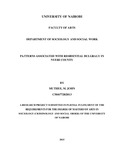| dc.description.abstract | Residential burglary is a centennial, universal and a worrisome crime for many people, since it leaves multiple, negative impacts on both property and victims. This research examined patterns associated with residential burglary in Nyeri County. The objectives of the research were to establish the social-demographic characteristics of victims of residential burglary; extent of residential burglary, the relationship between geographical location of households and residential burglary, to establish whether there is a connection between households‟ perceived wealth and residential burglary, to examine the relationship between time periods and residential burglary and to show whether there is a link between Security Measures in households and residential burglary. The research was guided by the Rational-Choice and Routine-Activity theories.
Descriptive survey research design was adapted in the study. The interview schedule was orally administered through face-to-face interviews to 94 respondents who included 41 victims and 41 non-victims of residential burglary randomly selected through stratified-proportionate sampling from six constituencies‟ and police stations‟ based strata and key informants who included 6 police investigation officers and 6 village elders purposively selected. The research instrument was pretested for reliability and validity. Data was analyzed by use of descriptive statistics and the Statistical Package for Social sciences (SPSS version 20) used in analyzing the data. Presentation of data findings is made through frequency tables and percentages, charts and graphs.
The research findings reveal a modal age class of 30-39 years for victimization and that residential burglary is on the decline. Most respondents have a proximate police presence, adequate power and mobile connectivity in neighbourhoods while re-victimization would lead to migration according to the findings. The findings indicate that households‟ perceived economic wealth makes them attractive burglary targets and that ownership of a small sized and rented house increases chances of being victimized. Items lost during burglary according to the research are mainly electronics. The dates towards end months; the month of April has high rates of burglary while the most vulnerable hours to burglary are between midnight and three in the morning. The research found-out that burglaries tend to peak on Friday and Monday nights and are followed by corresponding declines. Other research findings are that Community policing arrangements actively exist in most neighbourhoods and are considered highly useful in combating burglary among other crimes.
Conclusions drawn from the research is that factors related to geographical locations, households perceived wealth, critical times and security interventions in place are closely linked to the crime of residential burglary in Nyeri County while public lifestyles does not. Lastly recommended strategies to minimize residential burglary rates even further include increasing the police presence in neighbourhoods, educating the public on security, keeping the youth busy, providing affordable housing and community-police security partnerships. | en_US |

